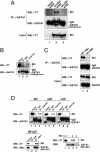Ski negatively regulates erythroid differentiation through its interaction with GATA1
- PMID: 15542823
- PMCID: PMC529047
- DOI: 10.1128/MCB.24.23.10118-10125.2004
Ski negatively regulates erythroid differentiation through its interaction with GATA1
Abstract
The Ski oncoprotein dramatically affects cell growth, differentiation, and/or survival. Recently, Ski was shown to act in distinct signaling pathways including those involving nuclear receptors, transforming growth factor beta, and tumor suppressors. These divergent roles of Ski are probably dependent on Ski's capacity to bind multiple partners with disparate functions. In particular, Ski alters the growth and differentiation program of erythroid progenitor cells, leading to malignant leukemia. However, the mechanism underlying this important effect has remained elusive. Here we show that Ski interacts with GATA1, a transcription factor essential in erythropoiesis. Using a Ski mutant deficient in GATA1 binding, we show that this Ski-GATA1 interaction is critical for Ski's ability to repress GATA1-mediated transcription and block erythroid differentiation. Furthermore, the repression of GATA1-mediated transcription involves Ski's ability to block DNA binding of GATA1. This finding is in marked contrast to those in previous reports on the mechanism of repression by Ski, which have described a model involving the recruitment of corepressors into DNA-bound transcription complexes. We propose that Ski cooperates in the process of transformation in erythroid cells by interfering with GATA1 function, thereby contributing to erythroleukemia.
Figures





Similar articles
-
Ski can negatively regulates macrophage differentiation through its interaction with PU.1.Oncogene. 2008 Jan 10;27(3):300-7. doi: 10.1038/sj.onc.1210654. Epub 2007 Jul 9. Oncogene. 2008. PMID: 17621263 Free PMC article.
-
Point mutations in two EVI1 Zn fingers abolish EVI1-GATA1 interaction and allow erythroid differentiation of murine bone marrow cells.Mol Cell Biol. 2006 Oct;26(20):7658-66. doi: 10.1128/MCB.00363-06. Epub 2006 Sep 5. Mol Cell Biol. 2006. PMID: 16954386 Free PMC article.
-
Homotypic signalling regulates Gata1 activity in the erythroblastic island.Development. 2004 Jul;131(13):3183-93. doi: 10.1242/dev.01198. Epub 2004 Jun 2. Development. 2004. PMID: 15175249
-
Transcriptional regulation of erythropoiesis. Fine tuning of combinatorial multi-domain elements.Eur J Biochem. 2002 Aug;269(15):3607-18. doi: 10.1046/j.1432-1033.2002.02999.x. Eur J Biochem. 2002. PMID: 12153557 Review.
-
[Function and transcriptional regulation of GATA-1].Seikagaku. 1999 Oct;71(10):1247-50. Seikagaku. 1999. PMID: 10572484 Review. Japanese. No abstract available.
Cited by
-
Nuclear interacting SET domain protein 1 inactivation impairs GATA1-regulated erythroid differentiation and causes erythroleukemia.Nat Commun. 2020 Jun 12;11(1):2807. doi: 10.1038/s41467-020-16179-8. Nat Commun. 2020. PMID: 32533074 Free PMC article.
-
Transcriptional cofactors Ski and SnoN are major regulators of the TGF-β/Smad signaling pathway in health and disease.Signal Transduct Target Ther. 2018 Jun 8;3:15. doi: 10.1038/s41392-018-0015-8. eCollection 2018. Signal Transduct Target Ther. 2018. PMID: 29892481 Free PMC article.
-
Ski and SnoN, potent negative regulators of TGF-beta signaling.Cell Res. 2009 Jan;19(1):47-57. doi: 10.1038/cr.2008.324. Cell Res. 2009. PMID: 19114989 Free PMC article. Review.
-
The GATA1s isoform is normally down-regulated during terminal haematopoietic differentiation and over-expression leads to failure to repress MYB, CCND2 and SKI during erythroid differentiation of K562 cells.J Hematol Oncol. 2012 Aug 1;5:45. doi: 10.1186/1756-8722-5-45. J Hematol Oncol. 2012. PMID: 22853316 Free PMC article.
-
Cinchona alkaloids as natural fetal hemoglobin inducing agents in human erythroleukemia cells.RSC Adv. 2019 Jun 4;9(31):17551-17559. doi: 10.1039/c9ra01744e. eCollection 2019 Jun 4. RSC Adv. 2019. PMID: 35520581 Free PMC article.
References
-
- Akiyoshi, S., H. Inoue, J. Hanai, K. Kusanagi, N. Nemoto, K. Miyazono, and M. Kawabata. 1999. c-Ski acts as a transcriptional co-repressor in transforming growth factor-beta signaling through interaction with smads. J. Biol. Chem. 274:35269-35277. - PubMed
-
- Beug, H., R. Dahl, P. Steinlein, S. Meyer, E. M. Deiner, and M. J. Hayman. 1995. In vitro growth of factor-dependent multipotential hematopoietic cells is induced by the nuclear oncoprotein v-Ski. Oncogene 11:59-72. - PubMed
-
- Boyes, J., P. Byfield, Y. Nakatani, and V. Ogryzko. 1998. Regulation of activity of the transcription factor GATA1 by acetylation. Nature 396:594-598. - PubMed
-
- Cantor, A. B., and S. H. Orkin. 2002. Transcriptional regulation of erythropoiesis: an affair involving multiple partners. Oncogene 21:3368-3376. - PubMed
-
- Chretien, S., A. Dubart, D. Beaupain, N. Raich, B. Grandchamp, J. Rosa, M. Goossens, and P. H. Romeo. 1988. Alternative transcription and splicing of the human porphobilinogen deaminase gene result either in tissue-specific or in housekeeping expression. Proc. Natl. Acad. Sci. USA 85:6-10. - PMC - PubMed
Publication types
MeSH terms
Substances
Grants and funding
LinkOut - more resources
Full Text Sources
Other Literature Sources
